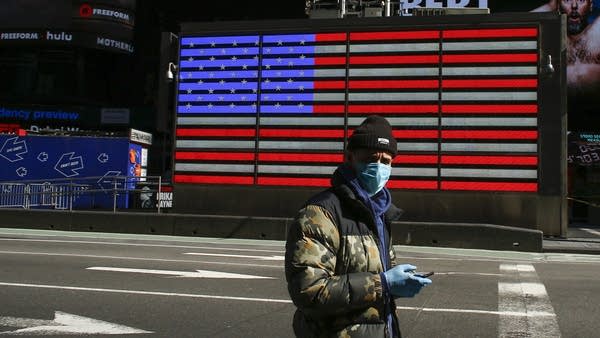Shanghai lockdown a year on: Is it still the same financial hub?
Shanghai’s 2022 lockdown, which lasted two months, left economic and psychological scars on the metropolis.

Shanghai is referred to as a financial hub because it has the stock market, the banks, the asset-management firms — and because it’s a place where people want to be and be seen.
But on March 28, 2022, this bustling city of 25 million went into a hard lockdown to curb a surge of COVID-19 cases.
What was announced as a two-phased, eight-day lockdown dragged on for over two months.
“I was very surprised that a city of over 20 million people could be shut down all of a sudden. How did we get food? Or see doctors? Those were the biggest challenges,” said contemporary artist Jin Shan. “I am surprised that I survived that.”
Jin came to Shanghai two decades ago because it was an arts hub. He said the city is now home to China’s two best art fairs.
Shanghai is also known for being a good place for international businesses; the European Union Chamber of Commerce has 620 members there.
Shanghai has “the biggest port. It is easy to access the government authorities. You get very fast and efficient service. You have a lot of very professional, well-educated talents,” said Bettina Schoen-Behanzin, chair of the Shanghai chapter of the EU Chamber of Commerce.
Through most of the pandemic, COVID restrictions in Shanghai were lighter in Shanghai than other Chinese cities.
That was how Ohio native Josh Vaughn, who was initially drawn to Shanghai for its jiujitsu martial arts scene, was able to launch a business called Black Shades, which sells sunglasses made from recycled and sustainable materials, in 2021. Back then, the city was still hosting open-air markets.

“We came in hot and for every pair that we sell, we remove a pound of plastic from the ocean,” Vaughn said over a Mexican meal. “We were doing five- [or] six-hour markets and we were removing like 50, 60 pounds of plastic from doing an event.”
That momentum went out the door about a year ago, when the highly infectious omicron variant hit Shanghai. At first, officials opted to seal a building, a corner or a block at a time. Frustrated citizens called on the authorities to make up their minds and lock down the whole city for a week to stamp out the outbreaks. The suggestion was batted down by the authorities.
“If Shanghai came to a complete stop, there would be many international cargo ships floating in the East China Sea. This would affect the economy of China and the rest of world,” a medical expert on Shanghai’s pandemic task force, Wu Fan, said at a news conference at the time.

Officials pledged to never mandate a citywide lockdown. Barely a day later, they announced that the east side of the city would be locked down for four days and then reopen. Then the west side would follow. But by the time the second half of Shanghai was headed into lockdown, the first half remained in quarantine. The metropolis was cut off from the rest of China and the world.
Food and daily supplies became an obsession, and they are still the key things people recall about the lockdown. Artist Jin said he was able to source 300 eggs at a time for his family of four but struggled to find floss.
“Usually, I use 20 inches of dental floss at a time because I like to comfortably wrap it around my fingers. But I had to ration during the lockdown, so I only used eight inches of floss at a time,” Jin said, adding that the uncertainty of the lockdown weighed on him.
People survived largely because of hardworking and entrepreneurial delivery folks like Wang Shiwei.

“I created [WeChat] group chats at different residential blocks. People would say what groceries they wanted. I’d try to find which shops were open and helped them deliver,” Wang said.
Once Wang left his home, he wasn’t allowed to return to his residence and slept in his minivan. He considered himself lucky.
“Other delivery folks slept on the street. There were many small tents under bridges. Some delivery guys carried a luggage with quilts and slept wherever they ended up that day,” he said.
Financial and factory workers also slept at their workplaces, and they never knew for how long. Smaller-scale lockdowns and constant testing continued even after Shanghai lifted the lockdown in early June.
“We had to live with very erratic decisions, high level of unpredictability, and this eroded for sure a lot of trust,” Schoen-Behanzin said. The EU chamber has released a Shanghai position paper urging Chinese officials to restore foreign business confidence.
She added that many companies still stock food and sleeping bags on-site in case China reverts to imposing lockdowns again — even though the country abandoned zero-COVID restrictions in early December and there were mass infections.
“People now are still not so sure if they can really trust because they are afraid that there might be a second wave [of infections]. You never know. And we have experienced this also in Europe [and] the U.S.,” she said.

There is still a lot of trauma. Many people could not step past their front door. During the lockdown, some people were forced to separate from their young children. Family pets were killed. If residents got sick or were exposed, they could be sent to a quarantine camp.
That happened to American entrepreneur Vaughn. “I was quarantined. I was sent to a hotel. Then I got sent to a hospital,” he said.
When asked to describe that experience, he took a long pause. “Unpleasant,” Vaughn said.
That may have been an understatement. But like many in this city, Vaughn prefers to mentally leave the lockdown behind. Today, Shanghai appears to be back to normal, but it’s not.
The subway is packed and malls are busy, but “there are no music festivals in Shanghai. There are no big-name actresses being seen around Shanghai,” Vaughn said. “I feel like five years ago, you had your top DJs, you had top performers coming here and putting on concerts and just having sellout shows.”
China only recently began resuming visas for foreign tourists and foreign performers.
Official statistics show that Shanghai’s population had increased throughout the pandemic until last year, when it declined by 185,000. That figure does not include foreigners, but the EU Chamber of Commerce has a rough estimate.
“About 25% of the German community left the city post-lockdown and a 20% decrease in the number of French and Italian nationals who registered in their respective Shanghai consulates,” Schoen-Behanzin said. “This is really a significant loss for China because foreign nationals, they are the best ambassadors to bridge the perception gap with European headquarters.”

Vaughn is unsure whether he will stay. He said people had advised him to shift his production to Southeast Asia, but he looked into it and thinks it’s not feasible because the machines for producing eyewear there are a bit outdated compared to China’s.
“China is still No. 1 in manufacturing in terms of being cost-efficient and having the technology,” Vaughn said. “Whenever new machines come out, China buys them, and the factories here replace their old stuff.”
For Chinese nationals, like courier Wang from central China, Shanghai is still the best place to make money. “There aren’t many job opportunities in my hometown. Shanghai’s consumption is bigger, which means I can earn more here,” he said.
Arist Jin said it will take a while for his industry to recover since art and the economy are intricately linked.
He couldn’t create during the lockdown, but he is starting to make sculptures again — ones with simpler designs and less decoration.
“I am still anxious, but time will make that memory fade,” Jin said.
The faster the economy rebounds, he added, the more confident people will be about Shanghai as a place to both live and work.
Additional research by Charles Zhang.













